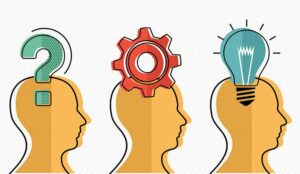One of the reasons some of your team members may be falling short on sales is that they don’t fully understand how emotion and logic influence the buying process.
At the end of this article, you’ll learn a simple and effective way to coach your team on why and how they need to use both emotion and logic in sales conversations. It’s a technique I’ve successfully used with teams around the world over the past 35 years.
Emotion vs. Logic in the Sales Process
When we think about sales – whether we’re making a purchase ourselves or observing someone else – most people buy based on emotion and justify the decision with logic afterward. Rarely does anyone logically decide to buy something and only then get excited about it later
My sweet ex-wife Anna is a great example of this. She has a black belt in shopping and can happily spend an entire day browsing shops. Now, I don’t want to give you the wrong idea, Anna’s not a shopaholic nor free with money… she just finds ‘shopping’ relaxing and therapeutic
Every now and then, after a shopping trip, Anna would show me a new item with her signature line: “Look at this, isn’t it cool?”
When I heard her say that, with a straight face, I’d usually say: Yeah, looks great. What did it cost? Then I start hearing all the logical reasons why we needed this particular treasure.
Buying on Emotion: Even Washing Powder
Now, I’m sure that there are some of you who will argue that people buy things based on logic, rather than emotion, all the time – take washing powder (or detergent depending on where you live).
Who gets emotional buying something like that? Well, I’d argue that emotion does play a part in buying that type of product too.
Years ago I had a meeting coming up the next day and wanted to wear my lucky shirt. But I had a problem – no washing powder to do a load of laundry to wash my lucky shirt!
So I head down to the shops to buy the brand I usually use and I’m walking down the aisle where all the washing powder is located, and do you think I can find the brand we use? You guessed it, not a chance.
The Logic Behind Choosing a Brand
Okay, I’m thinking, I can handle this, how hard can it be? Well, have you ever taken the time to consider how many different brands of washing powder there are in the world that you can choose from?
There must have been dozens and dozens of choices I could select from, and quite honestly, it was a little intimidating.
Now, I’m one of those shoppers who want to get in, buy what I want and get out. So, I started walking down the aisle looking at all the different brands (gasping at the prices) and reading all the labels.
Basically they all said the same thing – Ours is the best because we’ll clean your clothes and send the dirt down the drain! What else would you expect? We’re the crappiest brand, but really cheap?
Eventually I came across the brand we use but a different type of washing power. The price looked okay compared to the others I’d seen, so it was probably the safest option under the circumstances.
And, in the back of my mind, I was thinking: Well it’s the same brand that we usually use and not too expensive, so Anna shouldn’t have a problem with it.
The Emotional Value of Familiarity
Later, after Anna asked me why I decided to buy that brand…guess what I told her? Yep, I gave her all the logical reasons – I couldn’t find what we usually use, and it’s the same brand that we use and it wasn’t too expensive.
But when I thought about it later, the real reason I bought that particular washing powder, rather than any one of the dozens of choices I could have made, really came down to this – I recognized the brand, it was familiar to me, and it felt like the safest choice.
Some may argue I made the logical choice, but my buying decision was based on the emotional comfort of familiarity.
The Importance of Emotion in Sales Presentations
Always remember whenever delivering a sales presentation – people buy things because of the emotional value it provides them, and justify their purchase to themselves and others logically.
So when you’re in the Presentation Phase of the sales process, be sure to use emotion to drive the VALUE proposition, and provide strong logical reasons to justify the PRICE of buying!
The Power of Discovery in Sales
This is why it is so important to do a really good Discovery in your call process and Drill Down on the reason why something is important to the purchaser, so later you can enhance the value of what your product or services does for them, and belittle the price.
Understanding Value and Its Emotional Connection
The most important thing to find out in your Discovery phase is the VALUE a customer places on what the item will do for them – what it’s WORTH to them to have a problem solved, or the VALUE it adds to their lives. That’s pure emotion, or what is commonly referred to as their Hot Button!
Whenever people make a buying decision, they’ll weigh up the Pros and Cons of the product or service they’re looking to buy. If the Pros outweigh the Cons of buying, they’ll buy. And, if they don’t have the cash and think it’s really worthwhile, they’ll borrow the money if they have to!
If the Cons outweigh the Pros, they won’t buy, regardless of the price. For some people they wouldn’t have it even if it was free.
If the Pros and Cons are pretty much equal, depending how they feel at the moment (and the amount of money they have in their pocket), they’ll either buy it or not. But, if they had to borrow to pay for it, they’d likely pass.
Why Discovery is the Most Critical Part of a Sales Call
Of course, Value is subjective. What you value in a product may not hold the same value for others. That’s why the Discovery part of a sales call is the most critical part of making sales because you need to have a clear understanding of what a prospect wants, but more importantly the VALUE they place on it!

When you know the value they place on what the product or service does for them, you can personalize your presentation to really enhance the value of what you’re offering to tip the scales in your favour, by enhancing its VALUE, and belittling the Price to demonstrate its WORTH by how well it help them solve their problems, and how good they’ll feel when their problem is solved!
Written by: Marc Carriere for this article.
For more tips and advice from Marc Carriere, read our articles:
- The Best Ways of Providing Corrective and Nurturing Feedback
- 10 Red Flags to Watch Out for With New Hires
- How to Conduct a Skills Audit and Coaching Plan
Author: Marc Carriere
Reviewed by: Hannah Swankie
Published On: 15th Oct 2021 - Last modified: 24th Nov 2025
Read more about - Expert Insights, Emotion, Marc Carriere





































